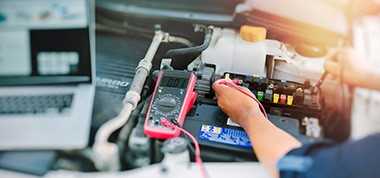|
|
What are the common solutions for DC power systems?Issuing time:2024-02-27 18:05 DC power supply systems are widely used in various power plants, substations and other power system core hubs
Introduction to the composition and function of DC power supply system The DC power supply system is widely used in various power plants, substations and other power system core hubs, and is composed of battery packs, charging devices, DC feeder screens, DC distribution cabinets, DC power monitoring devices, DC branch feeders, etc., to provide safe and reliable working power for relay protection devices, circuit breaker tripping, signal systems, DC chargers, UPS, communications and other subsystems. As the core equipment of the substation, the DC power supply system of the substation supplies power to the control equipment of the substation, and if the power supply is stopped due to failure, it will directly affect the normal operation of the substation. At present, most of the chargers use high-frequency switching power supply type, and the battery has also been upgraded from the initial acid-proof lead-acid battery to the VRLA sealed lead-acid battery, and is equipped with a DC power supply microcomputer monitoring device. The main functions of the battery pack in the operation of the DC power system: 1) When the mains power is interrupted or the DC charging equipment fails, the battery pack will supply power to the load separately to ensure that the power supply is not interrupted. 2) Under the short-circuit impact of the load or the initial impact of the normal load, the part exceeding the rated output of the charger shall be borne by the battery. 3) Smooth filtering. The battery pack has the same charging and discharging function as the capacitor, and the AC components are isolated, so that the AC components sent to the load are further reduced, and the voltage quality requirements of the load are guaranteed. The contents of the daily regular inspection of the battery pack and the common faults: 1) The VRLA battery operates in the mode of float charge in normal operation, the single float charge voltage value should be 2.23-2.28V, and the balanced charge should be 2.3-2.35V, and the terminal voltage value, float charge current value, single battery voltage value, ground resistance and insulation state of the battery pack and DC bus should be monitored during operation. 2) Daily regular inspection of the battery pack: terminal voltage measurement, internal resistance test, dynamic discharge test, AC input power switching test of charging device.
3) The function of the safety valve of the VRLA battery: the VRLA battery is in a sealed state under normal charging, and a safety valve that can be automatically opened and closed is installed. When the internal pressure exceeds the specified opening threshold, the safety valve will be automatically opened, and it will be automatically closed when the pressure is lower than the closing threshold. The safety valve is equipped with an acid filtration device, which will not discharge harmful gases such as acid mist, and will not leak electrolyte, which can prevent the battery from exploding due to sparks. 4) Common faults of VRLA batteries: abnormal VRLA shells and abnormal discharge voltages of VRLA batteries. Charging device protection function and operation monitoring The charger should have over-voltage, over-current, under-voltage, DC insulation monitoring, AC loss of voltage, AC phase loss and other protection and sound and light alarm functions. The daily inspection of the charger is essential, such as: whether the three-phase AC input voltage is balanced or missing, whether the operating noise is abnormal, whether the protection signals are normal, whether the AC input voltage value, DC output voltage value, DC output current value, etc. are correct, and whether the insulation state to the ground is good. If the AC power supply is interrupted, the battery pack will supply power to the load uninterruptedly, if there is no automatic voltage regulation device, manual voltage regulation should be carried out to ensure that the bus voltage is stable, and the AC power supply is restored, and the charging device should be started manually or automatically immediately. 2. Routine test during DC power system overhaul After the installation of the DC power supply system, the handover acceptance test should be carried out before it is put into operation, and the test project must meet the technical requirements, and the trial operation shall be normal for 72 hours. The main content of handover acceptance: Insulation monitoring and signal alarm device Withstand voltage and insulation test Battery pack capacity test Charging device current stabilization accuracy test Voltage regulation accuracy test of charging device Ripple coefficient test of charging device DC bus continuous power supply test |

